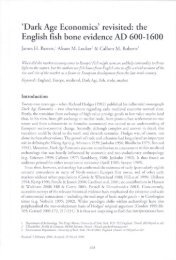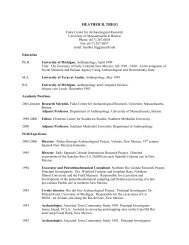Piracy in Late Roman Britain: A Perspective from the ... - Fiske Center
Piracy in Late Roman Britain: A Perspective from the ... - Fiske Center
Piracy in Late Roman Britain: A Perspective from the ... - Fiske Center
Create successful ePaper yourself
Turn your PDF publications into a flip-book with our unique Google optimized e-Paper software.
Britannia XXXVII (2006), 337-353<br />
<strong>Piracy</strong> <strong>in</strong> <strong>Late</strong> <strong>Roman</strong> Brita<strong>in</strong>: a<br />
<strong>Perspective</strong> <strong>from</strong> <strong>the</strong> Vik<strong>in</strong>g Age<br />
By ANDREW PEARSON<br />
INTRODUCTION<br />
One of <strong>the</strong> key issues concern<strong>in</strong>g late <strong>Roman</strong> Brita<strong>in</strong> is <strong>the</strong> nature of contacts with seafar<strong>in</strong>g<br />
peoples <strong>from</strong> <strong>the</strong> cont<strong>in</strong>ental North Sea coast. More often than not, <strong>the</strong>se <strong>in</strong>teractions<br />
have been seen as hostile, provok<strong>in</strong>g a military response <strong>from</strong> <strong>the</strong> <strong>Roman</strong>s that is most<br />
recognisable <strong>in</strong> <strong>the</strong> archaeological record by new and often massive coastal fortifications <strong>from</strong><br />
<strong>the</strong> third century onwards.<br />
Despite <strong>the</strong> many modern narratives on <strong>the</strong> subject, notions about <strong>the</strong> character of Germanic<br />
raid<strong>in</strong>g are poorly def<strong>in</strong>ed. In large part this is due to <strong>the</strong> absence of any detailed accounts of piracy<br />
<strong>in</strong> <strong>the</strong> historical record, and <strong>in</strong>deed contemporary references are so sparse that episodes of coastal<br />
attacks are entirely open to doubt.1 Archaeological traces of raid<strong>in</strong>g are even more rare, and this<br />
lack of evidence makes possible alternative assessments of late <strong>Roman</strong> military strategy around<br />
<strong>the</strong> British coast.2 The question has still wider implications, for it impacts upon our understand<strong>in</strong>g<br />
of <strong>the</strong> character of <strong>the</strong> transition <strong>from</strong> <strong>Roman</strong> Brita<strong>in</strong> to <strong>the</strong> Anglo-Saxon k<strong>in</strong>gdoms.<br />
By contrast, <strong>the</strong>re can be no doubt about <strong>the</strong> reality of Vik<strong>in</strong>g attacks on Brita<strong>in</strong>, Ireland, and<br />
<strong>in</strong>deed on a wider cont<strong>in</strong>ental stage. Historical records and archaeological evidence comb<strong>in</strong>e to<br />
give a picture (albeit one that is still <strong>in</strong>complete) of how raid<strong>in</strong>g developed dur<strong>in</strong>g this period<br />
and <strong>the</strong> manner <strong>in</strong> which it was conducted. It is argued below that <strong>the</strong>re is a basic similarity<br />
between <strong>the</strong> <strong>in</strong>itial phase of Vik<strong>in</strong>g attacks and those of <strong>the</strong> barbarians on <strong>the</strong> coast of <strong>Roman</strong><br />
Brita<strong>in</strong>. Us<strong>in</strong>g this premise, <strong>the</strong> present paper seeks to shed light on <strong>the</strong> issue of North Sea<br />
piracy dur<strong>in</strong>g <strong>the</strong> later centuries of <strong>Roman</strong> rule.<br />
COMPARING THE ROMAN AND VIKING ERAS<br />
All parallels between late <strong>Roman</strong> Brita<strong>in</strong> and <strong>the</strong> Anglo-Saxon k<strong>in</strong>gdoms are to an extent<br />
superficial and must be treated with caution. It is recognised <strong>from</strong> <strong>the</strong> outset that <strong>the</strong>re are<br />
many important dist<strong>in</strong>ctions between <strong>the</strong> early German <strong>in</strong>cursions and those of <strong>the</strong> later<br />
Scand<strong>in</strong>avians, <strong>from</strong> social milieu to maritime technology. There is, for example, considerable<br />
debate as to whe<strong>the</strong>r <strong>the</strong> Anglo-Saxons were capable of direct voyages over <strong>the</strong> North Sea, or<br />
if raid<strong>in</strong>g was only achievable by 'coastal crawl<strong>in</strong>g' and a cross<strong>in</strong>g at <strong>the</strong> Straits of Dover.3 The<br />
scale of <strong>the</strong> polities under attack, and <strong>the</strong> military capacity and organisation of <strong>Roman</strong> Brita<strong>in</strong><br />
and <strong>the</strong> Anglo-Saxon k<strong>in</strong>gdoms, were also markedly different.<br />
1 Bartholomew 1984; White 1961.<br />
2 Cotterill 1993; Pearson 2002; 2005.<br />
3 Contrast Cruml<strong>in</strong>-Pedersen 1990 with Carver 1990. On <strong>Roman</strong> and German sea-power see respectively Casey<br />
1994, ch. 12 and Haywood 1991.<br />
C World copyright reserved. Exclusive Licence to Publish: The Society for <strong>the</strong> Promotion of <strong>Roman</strong> Studies 2006









